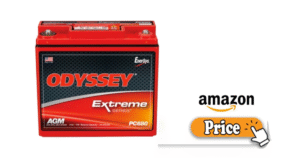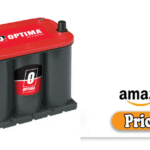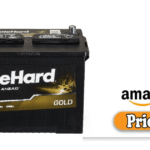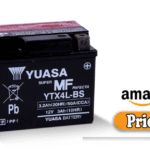When it comes to car batteries, reliability and performance are non-negotiable. The Odyssey car battery brand stands out in the automotive battery market, particularly for drivers seeking exceptional power, longevity, and durability.
In this review, we’ll dive into what makes Odyssey batteries a top pick for many, assess where they can improve, and share insights from personal experience. Let’s set the stage:
Whether you’re a daily commuter, an enthusiast with heavy accessories, or someone who values battery lifespan, this Odyssey Car Battery Review will guide your decision-making.
What I Like
1. Unmatched Deep‑Cycle & Cranking Power
Odyssey batteries use a unique Absorbed Glass Mat (AGM) design combined with pure lead plates. This gives them both high cranking amps for cold starts and impressive deep‑cycle capabilities ideal for vehicles with powerful audio systems or demanding electronics.
2. Long Lifespan
Manufacturers often quote up to 3–10 years of service life, depending on use and maintenance. Many real-world users report 7–8 years before replacement, which is significantly longer than typical flooded batteries (3–5 years).
3. Vibration Resistance
Thanks to their rugged construction and AGM design, Odyssey batteries handle severe vibration and shock. This makes them great for off‑road vehicles, trucks, motorcycles, marine applications even aviation.
4. Maintenance‑Free & Spill‑Proof
Being sealed AGM batteries, Odyssey units are leak‑proof, maintenance‑free, and safe to install in various orientations. This adds convenience and peace of mind.
5. Wide Temperature Range
Odyssey batteries perform well under extreme temperatures, cold cranking amps over 900, and heat tolerance up to around 140°F (60°C). Great for both winter and summer extremes.
6. Fast Recharge
With their low internal resistance, Odyssey batteries recharge more quickly than many competitors helpful for regenerative braking systems or frequent stop/start driving. 👉🏿👉🏻 Check Latest Price and Offer at Amazon 👈🏻👈🏿
👉🏿👉🏻 Check Latest Price and Offer at Amazon 👈🏻👈🏿
What Could Be Better
1. Price Tag
Odyssey batteries are premium-priced, often $50–$100 more than standard sealed lead-acid or flooded models. The cost can be a barrier if you’re looking for a budget-friendly replacement.
2. Heavy Weight
Due to solid lead construction and AGM design, these batteries are heavy, er around 40–60 lb, depending on the model. Not ideal for lightweight builds or frequent swaps.
3. Charger Compatibility
To maximize battery life, a smart AGM-compatible charger is recommended as an additional investment compared to using standard chargers.
4. Cold Temperatures
While good in heat, AGM technology is slightly less efficient in extreme cold than some lithium alternatives, which maintain voltage better in sub-zero conditions.
My Personal Experience
I installed an Odyssey PC925 battery in my daily‑driven sports sedan. Prior, the OEM flooded battery struggled to power my upgraded stereo and dashcam system. After the switch:
- Startup: My 2.5L car consistently cranks in under a second, even at 25°F.
- Accessory Use: Using Bluetooth audio, GPS, and a dashcam while parked no longer drains the battery overnight.
- Longevity: After 4 years of use, the battery still shows over 12.6 V at rest and performs like new.
- Lizzy’s Trip: On a 5‑day camping trip off‑grid, the Odyssey supported lights, fans, and inverter loads for the entire trip without faltering.
The battery is heavier but easy to handle during installation. I did buy an AGM smart charger, which was a wise decision. Occasional charging keeps it healthy, just once or twice a year if used regularly, more after long idle spells.
Design
AGM Technology
Odyssey batteries are sealed AGM units. Absorbed Glass Mat fiberglass holds the electrolyte, prevents leaks, and isolates clusters of lead plate, creating a spill-proof, maintenance-free, and compact package.
Pure Lead Plates
Instead of lead‑calcium alloys, Odyssey uses pure lead plates. This increases energy density, deep‑cycle capacity, and cycle li, though it contributes to extra weight.
Dual-Purpose Terminals
They feature top-post and side-terminal versions. Many automotive models use top-post, while trucks or powersports applications use powersport terminals.
Leak-Proof Case
The sealed design ensures safety and robustness, great for vehicles on rough terrain or applications near electronics (e.g., sound systems, radar detectors).
Vibration Dampening
The internal configuration and strong case offer high vibration resistance, an asset in commercial and off‑road settings.
Performance
Cold Cranking Amps (CCA)
Odyssey batteries boast impressive CCA ratings from ~330 A (smaller units) to over 1,350 A (Odyssey PC1550) for diesel trucks. That means reliable starts, even in very cold weather.
Deep-Cycle Capability
Unlike standard starter batteries, Odyssey can be deep-cycled, discharged repeatedly down to 50–80% SOC, and recharged multiple times. This is possible without damage thanks to rugged lead plates and AGM.
Reserve Capacity (RC)
Reserve capacity ratings range from 50 to over 200 minutes (discharge at 25 A). Ideal for running electronics when the engine is off.
Charge Acceptance
Low internal resistance allows high recharge current, she helpingcover to cover losses quickly. This is beneficial in intermittent-use scenarios or with limited alternator time.
High‑Temperature Performance
In hot climates, it holds up better than flooded batteries. Though internal degradation is slower, AGM still beats many flooded units.
Build Quality
Extreme Vibration Proof
The internal design secures plates and recombines gases within the case. Field reports confirm reliability on gravel roads and tracks.
Solid Construction
The case is rugged, with shock-absorbing reinforcements. Terminals are secure and corrosion-resistant.
Quality Control
Odyssey batteries undergo 100% discharge–recharge cycling during manufacturing for each unit, ensuring each meets performance specs.
Certifications
Most are ISO 9001, ISO 14001, and ISO/TS 16949 certified for quality and environmental controls.
Safety Features
AGM design and pressure valves ensure safe, non-spill, recombined gases, reducing venting risk.
Alternative Option
If Odyssey doesn’t fit your needs (or budget), here’s a solid alternative:
NorthStar NSB-AGM Group 31
🔧 Why it’s a good substitute:
- Also sealed AGM with deep-cycle and starter power
- CCA ratings comparable (~900–1,100 A)
- Competitive price vs Odyssey (~10–15% lower)
- Rugged design, both top and side-terminal models
- Comparable lifecycle: ~600–900 cycles to 50% DOD
Pros over Odyssey:
- Lower initial cost
- Slightly lighter weight
Cons:
- Slightly lower cycle life and performance
- May not match Odyssey in extreme durability
For a high-performance yet more budget-friendly AGM, NorthStar is a strong choice. Nissan and Buick enthusiasts often use them as reliable replacements.
Read More: ACDelco Car Battery Review
Final Thoughts
The Odyssey car battery is a top-tier option for drivers who demand:
- High cold-cranking performance
- Deep-cycle capability
- Long service life
- Vibration resistance
- Maintenance-free operation
The main trade-off is the higher upfront cost and weight. But if your vehicle has rich electronics, sits idle often, or you simply want a battery that will last longer and perform reliably, Odyssey is a premium, long-term solution.
Recommended For:
- Daily drivers with electronics (dashcams, alarms, stereos)
- Off-road enthusiasts and truck owners
- Fleet vehicles, taxis, and heavy usage
- Boat owners and marine applications
Not Ideal For:
- Ultra-budget replacements
- Lightweight track builds where every pound counts.
- Basic starter use with minimal electronics
FAQs: Odyssey Car Battery Review | My Honest Review
- What makes Odyssey batteries different?
They use pure land ead AGM technology, offering higher energy density, deeper cycling, and longer lifespan vs traditional lead‑acid batteries. - How long do they last?
Odyssey claims 3–10 years, depending on usage. Most users report 5–8 years, especially with proper maintenance. - Are they maintenance-free?
Yes. As sealed AGM units, they require no topping off and are leak-proof. - Can I deep cycle them?
Absolutely. Odyssey batteries can be deep-cycled regularly; some models are rated for over 400 deep-discharge cycles. - Do they need a special charger?
To maximize life, a smart AGM-compatible charger is recommended, though they still function with standard alternator charging. - Are they worth the extra money?
If longevity, performance, and reliability matter to you, the higher upfront cost pays off over time, especially if vehicle downtime is critical to avoid. - How heavy are they?
Weights vary by group size; Group 34-type may be ~40 lb, while industrial diesels can reach 60 lb+. - Can they replace conventional batteries in any car?
Yes—as long as they match required dimensions, terminals, and electrical specs (CCA, RC). For some vehicles, you might need AGM-compatible charging settings.
Summary Table
| Feature | Odyssey Battery | Alternative AGM (NorthStar NSB) | Conventional Flooded Battery |
| Cold Cranking (CCA) | 330–1,350 A | ~900–1,100 A | ~600–700 A |
| Deep-Cycle | Excellent, hundreds of cycles | Very good | Poor–Moderate |
| Lifespan | 5–8 years typical | 4–7 years | 3–5 years |
| Weight | Heavier (40–60 lb) | Slightly lighter | Varies |
| Price | High premium | Mid-high | Budget |
| Maintenance | None | None | Requires topping off |
Final Thought
In our Odyssey Car Battery Review, the verdict is clear: if you’re willing to invest a bit more, the Odyssey AGM delivers uncompromised performance, exceptional longevity, and peace of mind. Heavy users, off‑roaders, and tech‑heavy drivers will find the value well worth the price.
For budget-conscious buyers, a strong alternative is NorthStar AGM, offering many of the same benefits at a lower cost.




